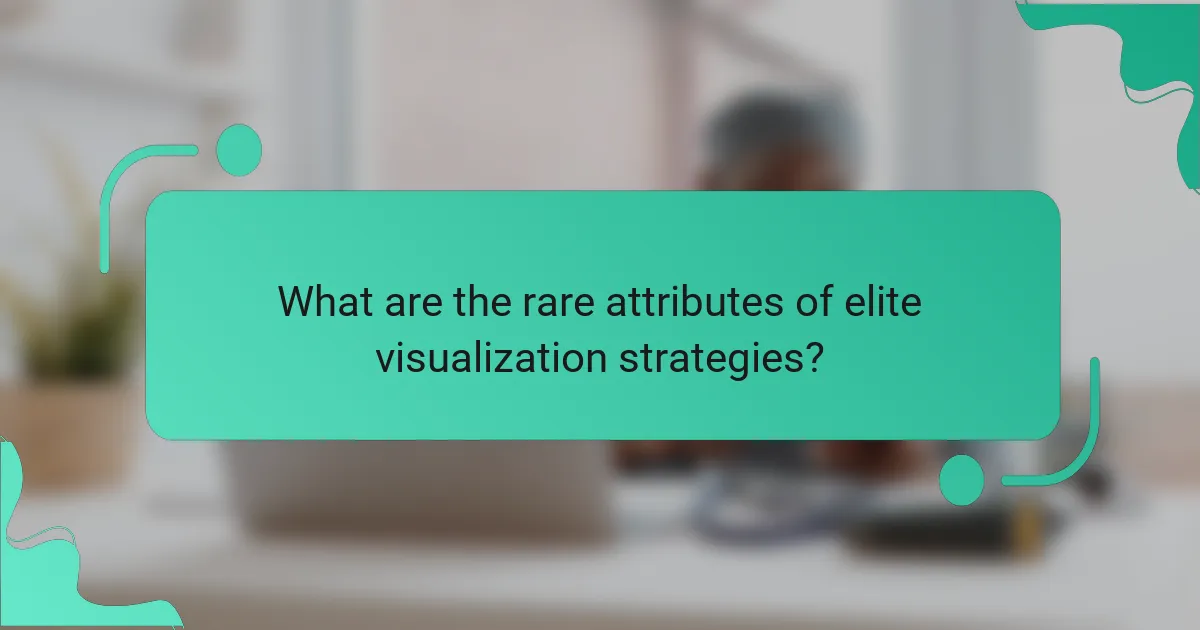Visualization techniques for athletes enhance performance and boost confidence by improving focus and managing inner dialogue. Key methods include mental imagery and guided imagery, which help reduce anxiety and increase motivation. Effective practices emphasize clarity, emotional engagement, and repetition, while advanced techniques integrate personalized imagery and real-time feedback. Mastering these strategies can lead to a resilient mindset and better execution during competitions.

What are Visualization Techniques for Athletes?
Visualization techniques for athletes enhance performance by improving focus and confidence. These techniques include mental imagery, where athletes visualize successful outcomes, and guided imagery, which involves listening to a narrative that leads them through a specific scenario. Studies show that these methods can significantly reduce anxiety and increase motivation, allowing athletes to better prepare for competitions. Consistent practice of visualization can lead to improved self-talk, reinforcing positive mental states and fostering resilience during challenging moments.
How do visualization techniques impact performance?
Visualization techniques significantly enhance athlete performance by improving focus and reducing anxiety. These techniques enable athletes to mentally rehearse their actions, leading to increased confidence and better execution during competition. Research shows that athletes who regularly practice visualization experience improved outcomes in their sports. For instance, studies indicate that mental imagery can enhance motor skills and overall performance metrics. This approach also aids in mastering inner dialogue, allowing athletes to maintain a positive mindset and overcome challenges effectively.
What role does self-talk play in visualization?
Self-talk significantly enhances visualization by reinforcing positive mental imagery. It shapes an athlete’s mindset, promoting confidence and focus during performance. Effective self-talk aligns with visualization techniques, creating a powerful synergy that boosts motivation and reduces anxiety. Athletes using constructive self-talk report improved outcomes and greater success in achieving their goals.

What are the universal attributes of effective visualization techniques?
Effective visualization techniques share universal attributes that enhance athletic performance and confidence. Key attributes include clarity, emotional engagement, specificity, and repetition. Clarity ensures that athletes can easily comprehend and execute their visualized scenarios. Emotional engagement connects athletes to their goals, boosting motivation. Specificity involves detailed imagery of the desired performance, while repetition reinforces mental pathways, making visualization more effective over time.
How can athletes use imagery to enhance focus?
Athletes can use imagery to enhance focus by visualizing successful performances and specific goals. This technique improves concentration and reduces anxiety. Visualization helps athletes mentally rehearse skills, leading to increased confidence and better execution during actual performance. Research shows that consistent practice of imagery can enhance neural pathways related to motor skills, reinforcing muscle memory.
What are the benefits of positive self-talk in visualization?
Positive self-talk enhances visualization by reinforcing confidence, improving focus, and reducing anxiety. This mental dialogue empowers athletes to visualize success effectively. By fostering a positive mindset, athletes can better engage with their visualization techniques, leading to improved performance outcomes. Studies show that athletes who practice positive self-talk alongside visualization experience greater motivation and resilience during competitions.

What unique attributes set apart advanced visualization techniques?
Advanced visualization techniques uniquely enhance athletes’ performance by incorporating immersive elements, personalized imagery, and real-time feedback. These techniques foster a deeper mental connection to training, allowing athletes to visualize success vividly. Unique attributes include tailored mental imagery that aligns with individual goals, the integration of sensory details to enrich the experience, and the ability to simulate competitive environments for effective practice.
How can athletes personalize their visualization practices?
Athletes can personalize their visualization practices by tailoring techniques to their specific goals and experiences. They should identify key performance areas, create vivid mental images, and incorporate sensory details relevant to their sport.
Additionally, athletes can adjust the frequency and duration of their visualization sessions based on individual preferences. By integrating positive affirmations and focusing on past successes, they can enhance motivation and confidence.
Finally, athletes should regularly evaluate and refine their visualization practices to ensure they align with evolving performance objectives. This adaptability fosters continuous improvement and mastery of inner dialogue.
What is the impact of visualization on mental resilience?
Visualization significantly enhances mental resilience by improving focus, reducing anxiety, and fostering a positive mindset. Athletes using visualization techniques report a boost in performance and confidence, allowing them to better manage stress and overcome challenges. Research shows that mental imagery can activate the same neural pathways as physical practice, reinforcing skills and enhancing overall mental toughness. This unique attribute of visualization contributes to athletes’ ability to maintain composure under pressure, ultimately leading to improved outcomes in competitive environments.

What are the rare attributes of elite visualization strategies?
Elite visualization strategies possess rare attributes that significantly enhance an athlete’s performance. These attributes include personalized imagery, multisensory integration, and emotional regulation. Personalized imagery allows athletes to visualize scenarios unique to their experiences, enhancing relevance and effectiveness. Multisensory integration engages multiple senses, creating a more immersive experience that strengthens neural pathways. Emotional regulation involves managing feelings during visualization, fostering resilience and focus under pressure. These rare attributes contribute to a comprehensive mental training approach, optimizing athletic performance and confidence.
How do professional athletes integrate visualization into training?
Professional athletes integrate visualization into training by mentally rehearsing performance scenarios. This technique enhances focus, builds confidence, and improves execution under pressure. Athletes often visualize successful outcomes, which reinforces positive self-talk and reduces anxiety. Research shows that consistent practice of visualization can lead to measurable improvements in performance metrics, such as reaction times and accuracy.
What cutting-edge techniques are emerging in athlete visualization?
Visualization techniques for athletes are evolving with innovative methods that enhance performance and build confidence. Emerging techniques include augmented reality (AR) applications, which allow athletes to visualize their movements in real-time, and virtual reality (VR) simulations that create immersive training environments. These technologies provide unique attributes such as personalized feedback and scenario-based training, improving mental rehearsal and focus. Additionally, biofeedback mechanisms are becoming popular, enabling athletes to visualize physiological data, which aids in mastering inner dialogue and stress management. As a result, athletes are better equipped to optimize their mental preparation and performance outcomes.

How can athletes effectively master their inner dialogue?
Athletes can master their inner dialogue through effective visualization techniques. These techniques enhance performance, boost confidence, and foster a positive mindset. Athletes should practice visualizing successful performances regularly, focusing on specific skills and scenarios. This mental rehearsal helps create neural pathways that improve execution during actual events. Additionally, incorporating positive affirmations during visualization can reinforce self-belief and combat negative thoughts. By consistently applying these techniques, athletes can develop a resilient inner dialogue that supports their goals.
What strategies can improve self-talk during competition?
Visualization techniques can significantly enhance self-talk during competition. Athletes can implement these strategies to foster a positive mindset and improve performance.
First, athletes should practice mental imagery by vividly picturing successful performances. This technique reinforces confidence and reduces anxiety. As a result, athletes can create a mental script that guides their actions during competition.
Second, incorporating affirmations into visualization can strengthen self-talk. By repeating positive statements, athletes can challenge negative thoughts and reinforce their belief in their abilities. This unique attribute helps in maintaining focus and motivation.
Lastly, athletes can visualize overcoming challenges. Imagining themselves successfully navigating obstacles prepares them mentally for real-life scenarios. This rare attribute enhances resilience and adaptability, crucial traits in competitive environments.
How does emotional regulation enhance visualization outcomes?
Emotional regulation significantly enhances visualization outcomes by fostering focus and reducing anxiety. When athletes manage their emotions effectively, they can visualize their performance with greater clarity and confidence. This leads to improved mental imagery, which is essential for executing skills and strategies. Studies show that athletes who practice emotional regulation techniques experience higher levels of performance and self-efficacy. By integrating emotional management into visualization practices, athletes can optimize their mental training and achieve better results.

What are best practices for implementing visualization techniques?
To effectively implement visualization techniques, athletes should focus on consistent practice, specific goal setting, and mental rehearsal. Regular visualization sessions enhance performance by creating mental pathways for success. Athletes should visualize not only the desired outcome but also the process, including overcoming challenges. Incorporating sensory details into visualization enhances realism, making the practice more effective. Lastly, integrating visualization into daily routines fosters confidence and promotes a positive inner dialogue, essential for peak performance.
How can athletes avoid common pitfalls in visualization?
Athletes can avoid common pitfalls in visualization by maintaining focus, setting realistic goals, and practicing regularly. Distractions can undermine the effectiveness of visualization, so creating a dedicated mental space is crucial. Setting achievable goals ensures that athletes do not become discouraged by unrealistic expectations. Regular practice reinforces the mental imagery, making it more effective over time.
What expert insights can enhance visualization practices for athletes?
Expert insights can significantly enhance visualization practices for athletes by focusing on tailored techniques. Techniques such as mental imagery, where athletes visualize successful performance scenarios, can improve focus and reduce anxiety. Research indicates that athletes who engage in consistent visualization experience a 20% increase in performance metrics. Incorporating sensory details into visualization, such as sounds and feelings associated with performance, enhances the effectiveness of these practices. Additionally, maintaining a positive inner dialogue during visualization can boost confidence and resilience, fostering a growth mindset essential for peak performance.
